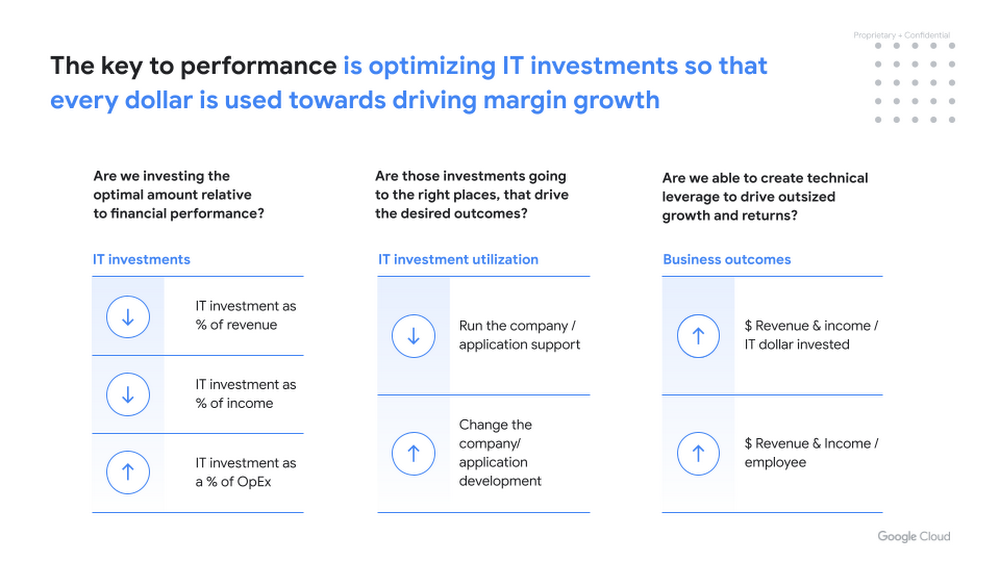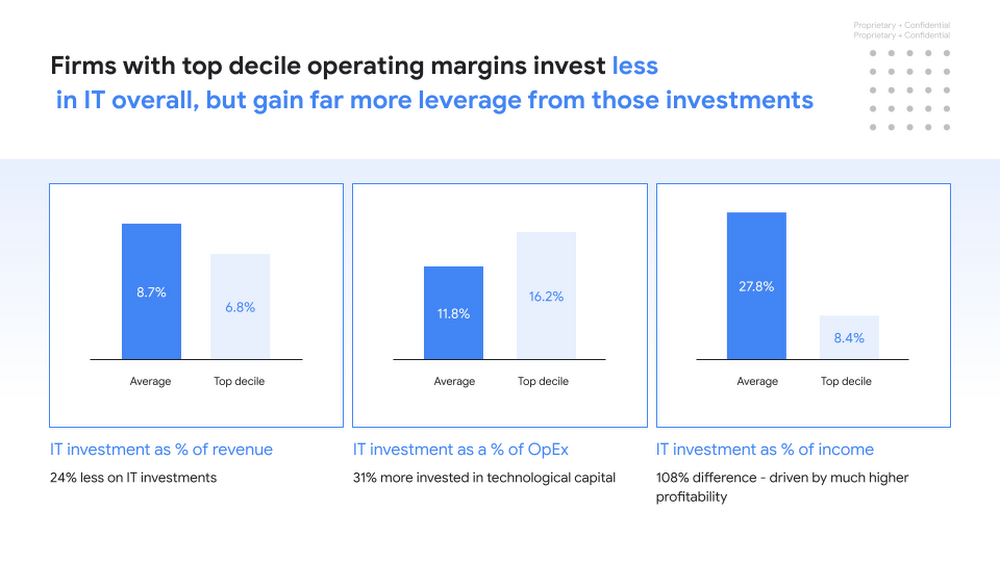Cloud Econ 103: Is your IT really performing if it's not benchmarked against the best?

James Tsai
Financial Services Lead, Customer Value & Transformation Advisory, Google Cloud
Howard Rubin
CEO, Rubin Worldwide
Just like other capital investments, cloud should be measured not only against internal metrics but also what the competition is doing.
Welcome back to cloud economics. In our previous sessions, we laid out the idea of treating your IT spend as investments in business performance; Cloud Econ 102, in particular, laid out a basic framework for measuring the impact of that performance over time. Now, we’ll dive deeper into this framework, its primary metrics, and how to benchmark it against both your organization’s performance and that of your leading peers to spot opportunities for optimization in the near and long term.
After all, investors and organizations have been counting on stock market indexes for centuries now to measure their portfolio performance. If we are going to start treating IT spending as a serious investment class within the enterprise — something we believe to be an essential mindset shift for business leaders — benchmarking the effectiveness of your IT against best-in-class organizations will be a crucial step.
Developing a performance measurement framework
Our measurement framework and metrics, as laid out previously, focus on investment levels, allocation, and the impact of IT investments:


This framework seeks to strengthen and highlight the links between:
- Investments in IT: Measuring IT investments as a percentage of revenue and income
- Improvements in operational costs: IT investments as a percentage of operating expenses, or OpEx
- Creation of new growth engines: The amount spent on running your technology stack vs. the amount spent on growing and transforming it (run the firm vs change the firm), and the cost of application development vs. application support
- Financial outcomes: Tracking revenue and income per IT dollar spent and per employee
Firms that invest their IT dollars well generally invest less in technology. However, they maximize the impact of those investments on revenue support and growth, as well as the containment of operating expenses. This ultimately shows up in a company’s operating margins.
The general conclusion here is that firms should seek to optimize their IT investments to drive returns in the form of operating-margin growth. You can achieve this not only by focusing on what you invest in but how you leverage your investments to drive the business forward. For instance, when investing in automation and growth initiatives you should also avoid creating more technology debt, over-provisioned computing environments, creating silos and redundant systems, and more.
Setting your investment baseline through peer benchmarking
Back in the 1880s, financial publishers began printing the first stock indexes so investors could measure their holdings against the market. If your individual railroad or oil holdings were up 10% in value that month, that was good. But if the entire index was up 30%, that actually meant your businesses had underperformed when compared to the competition.
Generations of investors have since used benchmarking to get a better sense of their ROI, and we believe there is a similar lesson for business and IT leaders when it comes to their technology investments. Not only should you know if your cloud and IT spend are contributing to the bottom line — it’s also important to know how your technology stack is performing relative to other best-in-class peers.
What constitutes a best-in-class peer, though? We define this as a company with a similar value chain and operating model, achieving top decile operating margins in your industry. For example, a retail bank should benchmark itself against other retail banks with top decile operating margins in the banking industry.
Here’s what this looks like in practice:


As these charts demonstrate, there is a clear difference between the IT investment performance of firms with top decile operating margins and those with average operating margins in a given industry. This example demonstrates the results discussed above: organizations with top decile operating margins invest less in IT overall but create more efficient and effective technology driven impact, and subsequently they see far better profitability for each dollar of IT budget they invest.
Setting your investment baseline
Before you can start benchmarking against peers, you’ll need to determine your own internal IT investment performance baseline.
This starts with alignment across your organization’s finance, technology, and operations groups about the right mix of KPIs, and their definitions, and then deciding which peers to measure your performance against. By bringing together the technical and business stakeholders to identify and quantify benchmarks as part of your organization’s larger cloud transformation, you’ll drive a natural alignment on why your organization is undergoing transformation, and the magnitude of results you should look to achieve.
While we believe there are particular advantages to the presented framework and associated KPIs, that often isn’t enough to measure success. Other metrics can and should be incorporated to further track the efficiency and effectiveness of your IT investments. This could include measurements around IT spend per customer served, or transaction processed or executed; and then how these metrics scale and change over time.
The rest of the process revolves around collecting the data to bring those KPIs to life and interpreting the results together to ensure alignment on their implications. The core challenge in this process is finding the peer performance data.
Organizations like Rubin Worldwide have been performing this type of benchmarking for some time, with pooled information provided by participants and bolstered by independent research. Google Cloud now also offers customers of its cloud service the ability to benchmark their IT investments against peers with top decile operating margins. (Contact cloudecon@google.com for more information on how to start benchmarking your IT against top peers.)
Identifying patterns and implications
When analyzing your performance, it is important to note that no single metric can tell the full story of your technology investments’ performance. The framework we’ve laid out should be considered akin to getting a blood panel during a physical exam. A high cholesterol level may flag a potential issue, but one test alone can’t tell you if you need to change your diet, improve your exercise regimen, take medication for a genetic issue, or require a combination of interventions.
IT investment benchmarking is no different — it’s the right first step, but it won’t be the last.
While it’s impossible to outline every permutation of possible outcomes from your benchmarking exercises, we have seen some consistent patterns emerge across our customer base:
- Optimizing IT investments to increase profit margins. In isolation, IT investment as a percentage of revenue or income doesn’t tell you much more than if you are spending more or less than your peers. It can, however, serve as the first of many clues that you might have room to invest more (if you’re lower than peers) or that you should be able to do more with less (higher than peers).
This is particularly true when combined with other indicators, such as revenue or income per dollar spent on running IT investments (not included in the core framework). This indicator can help measure the efficiency of core IT investments in supporting ongoing revenues and profit margins. A low figure here could mean that you have relatively more tech debt than peers, or run a less efficient environment than others. - Investing in automation to reduce costs. As mentioned, one important indicator is IT spend as a percentage of operating expenses (OpEx). This indicator is a great way to understand your reliance on non-IT-based resources and capital (people, in particular) when operating your business.
You might have room to invest more in automation and scale to bring your non-IT costs down and improve your overall margins if you are spending less on overall IT investments, OpEx, or generate less revenue per employee compared to your peers. - Increasing overall IT investments to enable growth. Lower IT investments overall — i.e., your IT spend isn’t helping to run or improve your technology spend or lower application development costs — could signal that you are missing an opportunity to invest more budget in growth initiatives.Tracking investments in operations and their ongoing effectiveness can sometimes reveal high levels of existing technology debt or areas for improvement that could help to streamline your IT landscape.
Taking control of your cloud economics is critical to achieving value from technology investments. Managing cloud economics goes beyond mere cost savings, performance metrics, or benchmarking your KPIs against peers — it provides guidance for strategic decision-making, resource allocation, and avenues for optimization.
Continuously revisiting your data and benchmarks, and comparing them with those in your industry, allows organizations to determine if their IT investments are continuing to yield the desired returns, and where there’s likely still work to do.
In Cloud Economics 104, we’ll introduce some important implications for your path to IT investment optimization that are unique to the cloud computing paradigm, as well as how you can leverage the power of the cloud’s scalability and flexibility to accelerate your organization’s digital transformation. Taken together, these can be instrumental in realizing value in our digital world.



